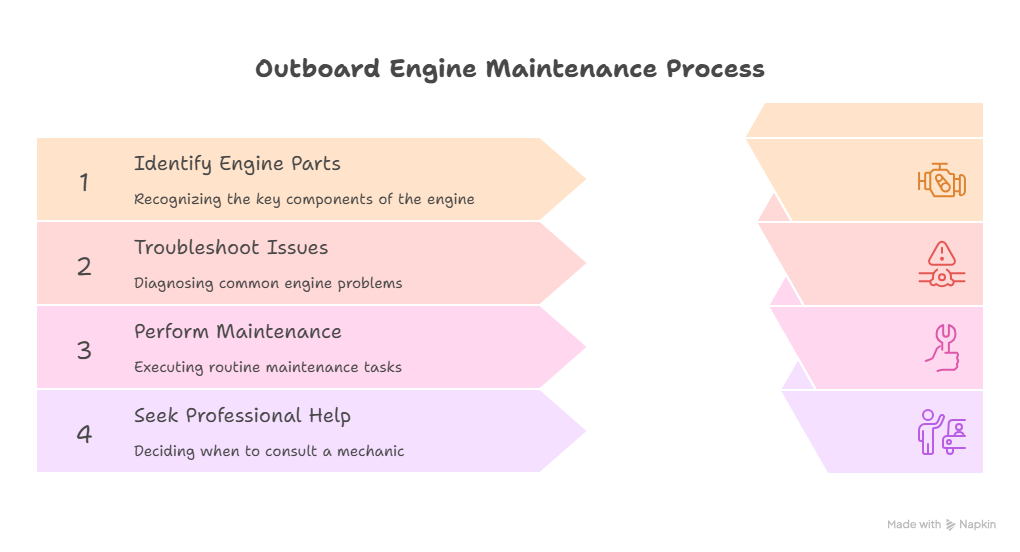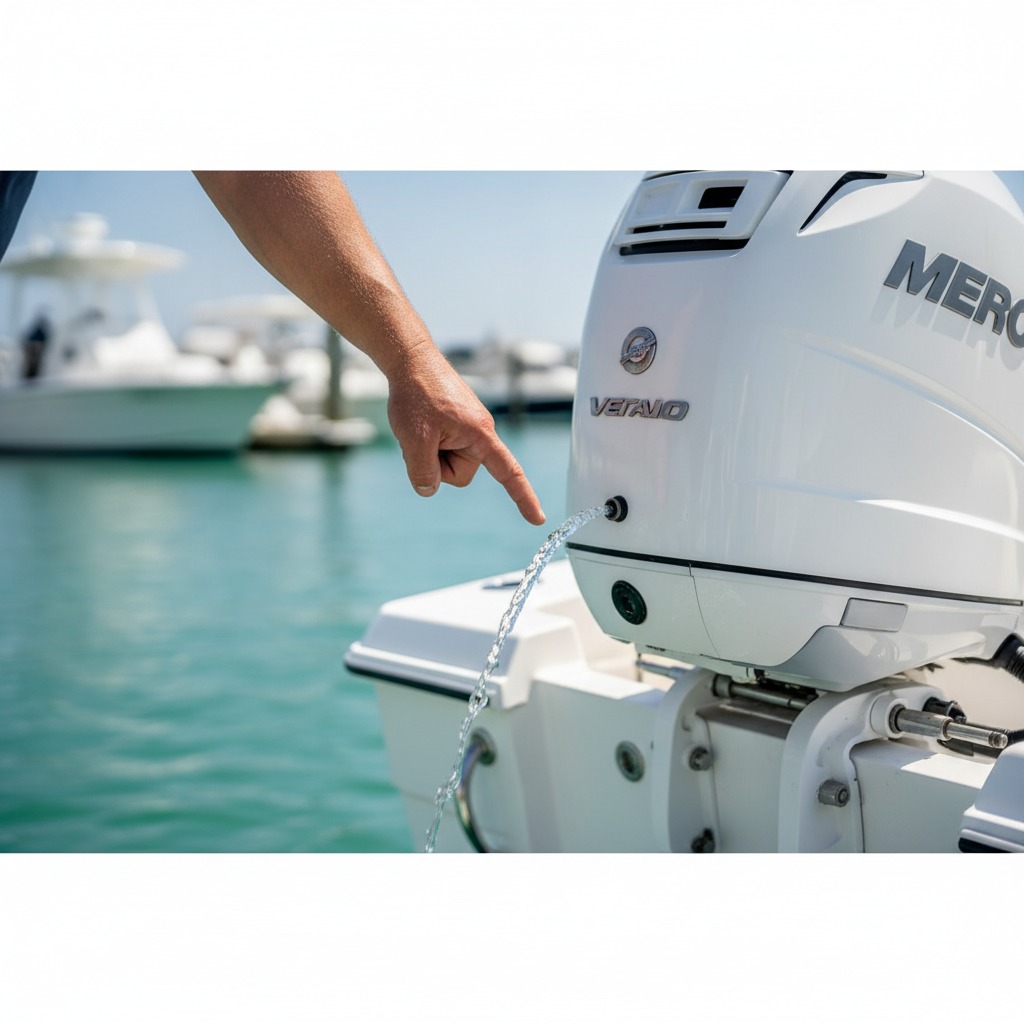I’ve been a marine mechanic in South Florida for over 15 years, and I’ve seen it all. From brand-new motors choked with bad fuel to vintage outboards brought back from the dead. The one thing that never changes is that a little knowledge goes a long, long way.
I remember a guy, Dave, who trailered his 22-foot Boston Whaler to my shop. He was frustrated. His engine would sputter and die every time he tried to get on plane. He’d already spent a few hundred bucks on parts he didn’t need and was ready to give up. He thought he needed a major, expensive marine outboard engine repair. Turns out, it was just a clogged fuel-water separator and a tired primer bulb. An hour of my time and less than $100 in parts, and he was back on Biscayne Bay the next day. He just needed to know where to look.
That’s what this guide is about. It’s not going to make you a certified tech overnight. But it will give you the confidence to understand what’s happening with your engine, tackle the simple stuff yourself, and make a smart call when you need professional help. This is the real-world guide to marine outboard engine repair.
Table of Contents
Understanding Your Outboard: It’s Not a Black Box
Before you can fix anything, you need a basic idea of what you’re looking at. Your outboard is a system of parts working together. Here’s the quick-and-dirty breakdown:
- The Powerhead: This is the top part of the engine under the cowling. It’s where the combustion happens—the heart of the operation.
- The Mid-Section: This connects the powerhead to the lower unit and includes the mounting brackets.
- The Lower Unit (or Gearcase): This is the part that’s in the water. It contains the gears that transfer power to your propeller.
Inside these sections, you have four critical systems: Fuel, Ignition, Cooling, and Exhaust. Most of the problems you’ll face will be in one of these four areas. Knowing this is the first step in any marine outboard engine repair diagnosis.
When Your Outboard Starts Talking Back: Troubleshooting 101
Your engine will almost always give you a warning before it quits entirely. The key is to listen.
Engine Won’t Start: This is the most common call I get. Before you panic, check the simple stuff. Is the kill switch lanyard attached? Is the shifter in neutral? Is the battery charged? You’d be surprised how many “major” problems are solved right there. If those are good, you move on to the basics: fuel and spark.
Loss of Power or Sputtering: If your engine is running rough, it’s usually starving for fuel or air. A clogged fuel filter is the #1 culprit here. I’ve lost count of the marine outboard engine repair jobs that were just a $10 filter change. Bad or old fuel, especially with ethanol, can also cause this.
Overheating: This is an engine killer. If you get an alarm or see steam, shut it down immediately. The most important thing to check is the “tell-tale” stream of water peeing out the back of the engine. If that stream is weak or gone, your water pump isn’t working. This is often a worn-out impeller, a small rubber part that is vital to your engine’s health. Changing it is a core part of any good marine outboard engine repair maintenance schedule.
An Ounce of Prevention: Keeping Your Outboard Happy
The best way to handle marine outboard engine repair is to avoid it in the first place. Proactive maintenance is your ticket to a reliable motor.
- Fuel, Fuel, Fuel: I can’t say it enough. Use good, fresh fuel and a stabilizer. Change your fuel-water separator filter every 50-100 hours. This will prevent 80% of the problems I see.
- Check Your Fluids: Routinely check your engine oil (on four-strokes) and your lower unit gear lube. If the gear lube looks milky, you have water getting in and need to get the seals replaced.
- Flush Your Engine: After every single use in saltwater, flush your engine with fresh water. Salt is the enemy. It corrodes everything it touches.
- Look at Your Prop: Check your propeller for dings, damage, or fishing line wrapped around the shaft. A damaged prop can cause vibrations that will wreck your engine over time.

DIY vs. Calling a Pro: Know Your Limits
I’m all for owners getting their hands dirty. It’s the best way to learn. But you also need to know when to put the tools down and pick up the phone. Here’s a quick cheat sheet based on my experience.
| Task | DIY or Pro? | My Take |
|---|---|---|
| Changing Fuel Filters | DIY | Easy. Every boat owner should know how to do this. |
| Spark Plugs & Oil Change | DIY | Absolutely. This is basic upkeep. |
| Water Pump/Impeller | DIY (with a manual) | A bit more involved, but a great skill to learn. |
| Carburetor Rebuild | DIY (if you’re patient) | Can be tricky, with lots of small parts. Take pictures as you go. |
| Electrical Gremlins | Pro | Chasing bad wires can be a nightmare without the right diagnostic tools. |
| Internal Engine Work | Pro | This is major surgery. A mistake here can destroy your engine. |
When you do need a pro for marine outboard engine repair, do your homework. Ask for recommendations at your local marina. Look for a mechanic who is certified for your engine brand. A good mechanic is a partner in keeping your boat on the water.
Finding a Good Mechanic and What to Expect
A good mechanic is worth their weight in gold. When you’re looking for a shop for marine outboard engine repair, ask these questions:
- What’s your hourly rate? (Expect $90-$150/hr).
- Are you certified for my engine brand?
- Do you warranty your work?
A reputable shop will be transparent about costs and keep you updated. The cost of a marine outboard engine repair can vary wildly. A simple service might be a few hundred dollars, while a major issue could run into the thousands. It’s an expensive hobby, but professional service is often cheaper than buying a new engine.
FAQ: Questions I Get Asked at the Dock
How often should I service my outboard?
Follow your owner’s manual, but a good general rule is once a year or every 100 hours. It’s the best investment you can make in your engine.
What’s the biggest mistake boat owners make?
Ignoring the small stuff. They hear a new noise or see a little drip and hope it goes away. It never does. It only gets worse and more expensive.
Is ethanol fuel really that bad?
For older engines, yes. It can eat away at fuel lines and clog up carburetors. Use non-ethanol fuel if you can find it. If not, use a good stabilizer.
My engine is really old. Is it worth fixing?
It depends. Some older outboards are legendary and worth rebuilding. But if parts are impossible to find or the corrosion is too advanced, it might be time to repower. A good mechanic can give you an honest assessment.
What’s the most important spare part to have on board?
A spare fuel filter. A clogged filter can shut you down in the middle of the water, but it’s a 10-minute fix if you have a spare.
The Bottom Line: Your Engine’s Health Is in Your Hands
At the end of the day, you are the captain of your ship, and that includes being the captain of your engine’s maintenance. You don’t need to be an expert in every aspect of marine outboard engine repair, but you need to be engaged.
- Know Your Engine: Understand the basic parts and systems. It makes troubleshooting much less intimidating.
- Listen to It: Pay attention to how it sounds and performs. Early detection is key.
- Do the Easy Stuff: Proactive maintenance like changing filters and flushing the engine will prevent most common failures.
- Trust the Tell-Tale: That little stream of water is your engine’s pulse. If it’s weak or gone, stop the engine.
- Find a Good Mechanic: Build a relationship with a certified tech before you have an emergency.
Taking charge of your marine outboard engine repair and maintenance is the best way to ensure you spend more time enjoying the water and less time being frustrated at the dock.
Author Bio
I’m Alex, a 15-year marine technician based in South Florida, with ABYC and Yamaha certifications. I specialize in marine outboard engine repair, from simple tune-ups to complex diagnostics on all major brands. I’ve spent thousands of hours in the shop and on the water, helping boaters from Key Largo to Fort Lauderdale keep their engines reliable.


Leave a Reply